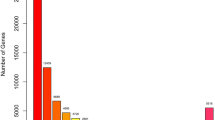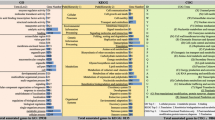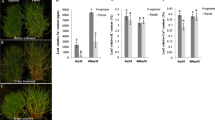Abstract
Key message
Nitraria sibirica Pall. regulates its tolerance to salt stress mainly by adjusting ion balance, modifying cell wall structure, and activating signal transduction pathways.
Abstract
N. sibirica, as a typical halophyte, can not only effectively restore saline-alkali land, but also has high economic value. However, studies on its salt tolerance at combining molecular and physiological levels were limited. In this study, the salt tolerance of N. sibirica was analyzed based on Pacbio full-length transcriptome sequencing, and the salt tolerance in the physiological level was verified by key genes. The results showed that 89,017 full-length transcripts were obtained, of which 84,632 sequences were annotated. A total of 86,482 coding sequences (CDS) were predicted and 6561 differentially expressed genes (DEGs) were identified. DEGs were significantly enriched in “sodium ion homeostasis”, “response to osmotic stress”, “reactive oxygen species metabolic process”, “defense response by cell wall thickening”, “signal transduction”, etc. The expression levels for most of these DEGs increased under salt stress. A total of 69 key genes were screened based on weighted gene co-expression network analysis (WGCNA), of which 33 were first reported on salt tolerance. Moreover, NsRabE1c gene with the highest expression level was selected to verify its salt tolerance. Over-expression of NsRabE1c gene enhanced the germination potential and root length of transgenic Arabidopsis thaliana plants without salt treatment as compared to those of Col-0 and AtRabE1c mutant. The expression levels of NsRabE1c decreased in the growth stagnation phase, while significantly increased in the growth recovery phase under salt stress. We predicted that NsRabE1c gene help N. sibirica resist salt stress through the regulation of plant growth. The results of this study deepen the understanding of salinity resistance in N. sibirica.













Similar content being viewed by others
Data availability
All data generated or analyzed during this study are included in this published article.
References
Ahanger MA, Aziz U, Alsahli AA et al (2020) (2019) Influence of exogenous salicylic acid and nitric oxide on growth, photosynthesis, and ascorbate-glutathione cycle in salt stressed Vigna angularis. Biomolecules 10(1):42
Ahmad P, Latef AAA, Hashem A et al (2016) Nitric oxide mitigates salt stress by regulating levels of osmolytes and antioxidant enzymes in chickpea. Front Plant Sci 7(868):347
Ahmad P, Ahanger MA, Alyemeni MN et al (2018) Mitigation of sodium chloride toxicity in Solanum lycopersicum L. by supplementation of jasmonic acid and nitric oxide. J Plant Interact 13(1):64–72
Bacete L, Schulz J, Engelsdorf T et al (2022) THESEUS1 modulates cell wall stiffness and abscisic acid production in Arabidopsis thaliana. P Nati Acad Sci 119(1):e2119258119
Bargmann BOR, Laxalt AM, ter Riet B et al (2009) Multiple PLDs required for high salinity and water deficit tolerance in plants. Plant Cell Physiol 50(1):78–89
Bassil E, Tajima H, Liang YC et al (2011) The Arabidopsis Na+/H+ antiporters NHX1 and NHX2 control vacuolar pH and K+ homeostasis to regulate growth, flower development, and reproduction. Plant Cell 23(9):3482–3497
Chen D, He L, Lin M et al (2021) A ras-related small GTP-binding protein, RabE1c, regulates stomatal movements and drought stress responses by mediating the interaction with ABA receptors. Plant Sci 306:110858
Chinnusamy V, Zhu J, Zhu JK (2006) Salt stress signaling and mechanisms of plant salt tolerance. Genet Eng 27:141–177
Decreux A, Messiaen J (2005) Wall-associated kinase WAK1 interacts with cell wall pectins in a calcium-induced conformation. Plant Cell Physiol 46(2):268–278
Dong L, Liu H, Zhang J et al (2015) Single-molecule real-time transcript sequencing facilitates common wheat genome annotation and grain transcriptome research. BMC Genomics 16:1039
Duszyn M, Świeżawska B, Szmidt-Jaworska A et al (2019) Cyclic nucleotide gated channels (CNGCs) in plant signalling—current knowledge and perspectives. J Plant Physiol 241:153035
Engelsdorf T, Gigli-Bisceglia N, Veerabagu M et al (2018) The plant cell wall integrity maintenance and immune signaling systems cooperate to control stress responses in Arabidopsis thaliana. Sci Signal. https://doi.org/10.1126/scisignal.aao3070
Faizan M, Bhat JA, Chen C et al (2021) Zinc oxide nanoparticles (ZnO-NPs) induce salt tolerance by improving the antioxidant system and photosynthetic machinery in tomato. Plant Physiolo Bioch 161(4):122–130
Feng W, Kita D, Peaucelle A et al (2018) The FERONIA receptor kinase maintains cell-wall integrity during salt stress through Ca2+ signaling. Curr Biol 28(5):666–675
Flowers TJ, Colmer TD (2008) Salinity tolerance in halophytes. New Phytol 179:945–963
Gao Z, He X, Zhao B et al (2010) Overexpressing a putative aquaporin gene from wheat, TaNIP, enhances salt tolerance in transgenic Arabidopsis. Plant Cell Physiol 51(5):767–775
Geng X, Lou J, Tie Y et al (2018) Isolation and expression analysis of plasmalemma Na+/H+ antiporter gene from Nitraria sibirica. Acta Bot Boreal-Occident Sin 38:1428–1436 ((in Chinese))
Gigli-Bisceglia N, van Zelm E, Huo W et al (2020) Salinity stress-induced modification of pectin activates stress signaling pathways and requires HERK/THE and FER to attenuate the response. BioRxiv 10(18):423458
Han X, Yang Y (2021) Phospholipids in salt stress response. Plants 10(10):2204
Hill AE, Shachar-Hill Y (2015) Are aquaporins the missing transmembrane osmosensors? J Membrane Biol 248(4):753–765
Hirano T, Sato MH (2011) Arabidopsis FAB1A/B is possibly involved in the recycling of auxin transporters. Plant Signal Behav 6(4):583–585
Hunkeler AK (2021) PTEN-mediated intracellular trafficking is crucial for xylem differentiation in Arabidopsis thaliana roots. Dissertation, ETH Zürich
Jin H, Dong D, Yang Q et al (2016) Salt-responsive transcriptome profiling of Suaeda glauca via RNA sequencing. PLoS One 11(3):e0150504
Karahara I, Ikeda A, Kondo T et al (2004) Development of the Casparian strip in primary roots of maize under salt stress. Planta 219(1):41–47
Katiyar-Agarwal S, Zhu J, Kim K et al (2006) The plasma membrane Na+/H+ antiporter SOS1 interacts with RCD1 and functions in oxidative stress tolerance in Arabidopsis. P Nati Acad Sci 103:18816–18821
Kaya C, Higgs D, Ashraf M et al (2020) Integrative roles of nitric oxide and hydrogen sulfide in melatonin-induced tolerance of pepper (Capsicum annuum L.) plants to iron deficiency and salt stress alone or in combination. Physiol Plantarum 168(2):256–277
Kim SH, Woo DH, Kim JM et al (2011) Arabidopsis MKK4 mediates osmotic-stress response via its regulation of MPK3 activity. Biochem Bioph Res Co 412:150–154
Kong X, Pan J, Zhang M et al (2011) ZmMKK4, a novel group C mitogen-activated protein kinase kinase in maize (Zea mays), confers salt and cold tolerance in transgenic Arabidopsis. Plant Cell Environ 34:1291–1303
Kronzucker HJ, Britto DT (2011) Sodium transport in plants: a critical review. New Phytol 189:54–81
Kumar MN, Jane WN, Verslues PE (2013) Role of the putative osmosensor Arabidopsis histidine kinase1 in dehydration avoidance and low-water-potential response. Plant Physiol 161(2):942–953
Li Y (2008) Kinetics of the antioxidant response to salinity in the halophyte Limonium bicolor. Plant Soil Environ 54:493–497
Li C (2016) Cloning and characterization of high-affinity K+ transporter gene from nitraria sibirica pall. Dissertation, Inner Mongolia University (in Chinese)
Li H, Tang X, Yang X et al (2017a) De novo transcriptome characterization, gene expression profiling and ionic responses of Nitraria sibirica Pall. under salt stress. Forests 8(6):211
Li W, Xu G, Alli A et al (2017b) Plant HAK/KUP/KT K+ transporters: function and regulation. Semin Cell Dev Biol 74:133–141
Li R, Chai W, Guo X et al (2020) Effect of salt treatment on osmotic adjustment of Apocynum venetum seedlings. Mol Plant Breeding 12:4105–4110 ((in Chinese))
Li H, Tang X, Yang X et al (2021) Comprehensive transcriptome and metabolome profiling reveal metabolic mechanisms of Nitraria sibirica Pall. to salt stress. Sci Rep 11:12878
Li J, Guo Y, Yang Y (2022) The molecular mechanism of plasma membrane H+-ATPases in plant responses to abiotic stress. J Genet Genomics 49(8):715–725
Lin L, Wu J, Jiang M et al (2021) Plant mitogen-activated protein kinase cascades in environmental stresses. Int J Mol Sci 22(4):1543
Liu J, Zhang W, Long S et al (2021a) Maintenance of cell wall integrity under high salinity. Int J Mol Sci 22(6):3260
Liu W, Wang H, Wang X et al (2021b) Alleviating effect of exogenous GABA on injury of Nitraria siberia Pall. seedlings induced by salt stress. J Northeast Agr Univ 52:34–40 ((in Chinese))
Luo Y, Zhuo W, Chen Q et al (2019) Cloning and expression patterns analysis of NtNHX2 gene in Nicotiana tabacum under different stress. Mol Plant Breed 17(16):5224–5229 ((in Chinese))
Lv S, Jiang P, Tai F et al (2017) The V-ATPase subunit A is essential for salt tolerance through participating in vacuolar Na+ compartmentalization in Salicornia europaea. Planta 246:1177–1187
Ma L, Liu X, Lv W et al (2022) Molecular mechanisms of plant responses to salt stress. Front Plant Sci 13:934877
Menga V, Trono D (2020) The molecular and functional characterization of the durum wheat Lipoxygenase TdLOX2 suggests its role in hyperosmotic stress response. Plants 9:1233
Monniaux M, Hay A (2016) Cells, walls, and endless forms. Curr Opin Plant Biol 34:114–121
Munns R (2005) Genes and salt tolerance: bringing them together. New Phytol 167:645–663
Munns R, Tester M (2008) Mechanisms of salinity tolerance. Annu Rev Plant Biol 59:651–681
Nadarajah KK (2020) ROS homeostasis in abiotic stress tolerance in plants. Int J Mol Sci 21:5208
Ni L, Wang Z, Guo J et al (2021) Full-length transcriptome sequencing and comparative transcriptome analysis to evaluate drought and salt stress in Iris lactea var. chinensis. Genes 12:434
Nieves-Cordones M, Alemán F, Martínez V et al (2014) K+ uptake in plant roots. The systems involved, their regulation and parallels in other organisms. J Plant Physiol 171:688–695
Ning J, Li X, Hicks LM et al (2010) A Raf-like MAPKKK gene DSM1 mediates drought resistance through reactive oxygen species scavenging in rice. Plant Physiol 152:876–890
Nongpiur RC, Singla-Pareek SL, Pareek A (2020) The quest for osmosensors in plants. J Exp Bot 71:595–607
Orr RG, Furt F, Warner EL et al (2021) Rab-E and its interaction with myosin XI are essential for polarised cell growth. New Phytol 229(4):1924–1936
Pantha P, Dassanayake M (2020) Living with salt. Innovation 1(3):100050
Raja KV, Sekhar KM, Reddy VD et al (2021) Activation of CDC48 and acetyltransferase encoding genes contributes to enhanced abiotic stress tolerance and improved productivity traits in rice. Plant Physiol Bioch 168:329–339
Scholz P, Pejchar P, Fernkorn M et al (2022) Diacylglycerol kinase 5 regulates polar tip growth of tobacco pollen tubes. New Phytol 233(5):2185–2202
Sun J, Chen SL, Dai SX et al (2009) Ion flux profiles and plant ion homeostasis control under salt stress. Plant Signal Behav 4:261–264
Sun M, Huang D, Zhang A et al (2020) Transcriptome analysis of heat stress and drought stress in pearl millet based on Pacbio full-length transcriptome sequencing. BMC Plant Biol 20:323
Sun S, Lin M, Qi X et al (2021) Full-length transcriptome profiling reveals insight into the cold response of two kiwifruit genotypes (A. arguta) with contrasting freezing tolerances. BMC Plant Biol 21:365
Takahashi F, Mizoguchi T, Yoshida R et al (2011) Calmodulin-dependent activation of MAP kinase for ROS homeostasis in Arabidopsis. Mol Cell 41:649–660
Tang X, Yang X, Li H et al (2018) Maintenance of K+/Na+ balance in the roots of Nitraria sibirica Pall. in response to NaCl stress. Forests 9:601
Tang X, Zhang H, Shabala S et al (2021) Tissue tolerance mechanisms conferring salinity tolerance in a halophytic perennial species Nitraria sibirica Pall. Tree Physiol 41:1264–1277
Teige M, Scheikl E, Eulgem T et al (2004) The MKK2 pathway mediates cold and salt stress signaling in Arabidopsis. Mol Cell 15:141–152
Tiika RJ, Wei J, Cui G et al (2021) Transcriptome-wide characterization and functional analysis of xyloglucan endo-transglycosylase/hydrolase (XTH) gene family of Salicornia europaea L. under salinity and drought stress. BMC Plant Biol 21:491
Tran LSP, Urao T, Qin F et al (2007) Functional analysis of AHK1/ATHK1 and cytokinin receptor histidine kinases in response to abscisic acid, drought, and salt stress in Arabidopsis. P Nati A Sci 104:20623–20628
van Zelm E, Zhang Y, Testerink C (2020) Salt tolerance mechanisms of plants. Annu Rev Plant Biol 71:403–433
Wang J, Ding H, Zhang A et al (2010) A novel mitogen-activated protein kinase gene in maize (Zea mays), ZmMPK3, is involved in response to diverse environmental cues. J Integr Plant Biol 52:442–452
Wang L, Ma YK, Li NN et al (2016) Isolation and characterization of a tonoplast Na+/H+ antiporter from the halophyte Nitraria sibirica. Biol Plantarum 60:113–122
Wang X, Yan YQ, Yin Y et al (2019) Effect of exogenous γ-aminobutyric acid (GABA) on photosynthetic characteristics of Nitraria sibirica pall. under salt stress. Jiangsu J Agr Sci 35:1032–1039 ((in Chinese))
Wang X, Zhou Y, Xu Y et al (2021) A novel gene LbHLH from the halophyte Limonium bicolor enhances salt tolerance via reducing root hair development and enhancing osmotic resistance. BMC Plant Biol 21:284
Wei J, Tiika RJ, Cui G et al (2022) Transcriptome-wide identification and expression analysis of the KT/HAK/KUP family in Salicornia europaea L. under varied NaCl and KCl treatments. PeerJ 10:e12989
Wu F, Chi Y, Jiang Z et al (2020) Hydrogen peroxide sensor HPCA1 is an LRR receptor kinase in Arabidopsis. Nature 578:577–581
Xu Z, Wang M, Ren T et al (2021) Comparative transcriptome analysis reveals the molecular mechanism of salt tolerance in Apocynum venetum. Plant Physiol Bioch 167:816–830
Yang Y, Guo Y (2018a) Elucidating the molecular mechanisms mediating plant salt-stress responses. New Phytol 217:523–539
Yang Y, Guo Y (2018b) Unraveling salt stress signaling in plants. J Integr Plant Biol 60:796–804
Yu Z, Duan X, Luo L et al (2020) How plant hormones mediate salt stress responses. Trends Plant Sci 25:1117–1130
Yu W, Wu W, Zhang N et al (2022) Research advances on molecular mechanism of salt tolerance in Suaeda. Biology 11:1273
Yuan F, Yang H, Xue Y et al (2014) OSCA1 mediates osmotic-stress-evoked Ca2+ increases vital for osmosensing in Arabidopsis. Nature 514(7522):367–371
Zhang H, Du C, Wang Y et al (2016a) The reaumuria trigyna leucoanthocyanidin dioxygenase (RtLDOX) gene complements anthocyanidin synthesis and increases the salt tolerance potential of a transgenic Arabidopsis LDOX mutant. Plant Physiol Bioch 106:278–287
Zhang M, Smith JAC, Harberd NP et al (2016b) The regulatory roles of ethylene and reactive oxygen species (ROS) in plant salt stress responses. Plant Mol Biol 91(6):651–659
Zhang J, Li Y, Liu B et al (2018) Characterization of the Populus Rab family genes and the function of PtRabE1b in salt tolerance. BMC Plant Biol 18(1):124
Zhao C, Zhang H, Song C et al (2020) Mechanisms of plant responses and adaptation to soil salinity. Innovation 1:100017
Zhao S, Zhang Q, Liu M et al (2021a) Regulation of plant responses to salt stress. Int J Mol Sci 22:4609
Zhao Y, Liu W, Wang H et al (2021b) Effects of exogenous CaCl2 on reactive oxygen species metabolism in Nitraria sibirica under NaCl stress. Plant Physiol J 57:1105–1112 ((in Chinese))
Zhu Y, Wang Q, Gao Z et al (2021) Analysis of phytohormone signal transduction in Sophora alopecuroides under salt stress. Int J Mol Sci 22:7313
Acknowledgements
This work was supported by the National Natural. Science Foundation of China (31770437). We thank Xu Yan in Huazhong Agricultural University for technical support in the analysis of the transcriptome sequencing data.
Funding
This work was supported by the Natural Science Foundation of China (31770437).
Author information
Authors and Affiliations
Contributions
PZ and YY designed the experiments. PZ and FZ performed most of the experiments. ZW and SC extracted the RNA and conducted the transgenic experiments. PZ and WL wrote the original draft. FZ, WL and YY revised the paper. All authors have read and approved to the published version of the manuscript.
Corresponding authors
Ethics declarations
Conflict of interest
The authors declare that there is no conflict of interest.
Additional information
Communicated by Sheng Ying.
Publisher's Note
Springer Nature remains neutral with regard to jurisdictional claims in published maps and institutional affiliations.
Supplementary Information
Below is the link to the electronic supplementary material.
Rights and permissions
Springer Nature or its licensor (e.g. a society or other partner) holds exclusive rights to this article under a publishing agreement with the author(s) or other rightsholder(s); author self-archiving of the accepted manuscript version of this article is solely governed by the terms of such publishing agreement and applicable law.
About this article
Cite this article
Zhang, P., Zhang, F., Wu, Z. et al. Analysis on the salt tolerance of Nitraria sibirica Pall. based on Pacbio full-length transcriptome sequencing. Plant Cell Rep 42, 1665–1686 (2023). https://doi.org/10.1007/s00299-023-03052-3
Received:
Accepted:
Published:
Issue Date:
DOI: https://doi.org/10.1007/s00299-023-03052-3




